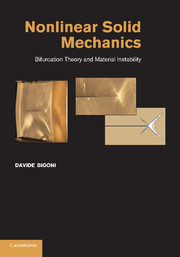Book contents
- Frontmatter
- Contents
- Preface
- Foreword by Giulio Maier
- 1 Introduction
- 2 Elements of tensor algebra and analysis
- 3 Solid mechanics at finite strains
- 4 Isotropic non-linear hyperelasticity
- 5 Solutions of simple problems in finitely deformed non-linear elastic solids
- 6 Constitutive equations and anisotropic elasticity
- 7 Yield functions with emphasis on pressure sensitivity
- 8 Elastoplastic constitutive equations
- 9 Moving discontinuities and boundary value problems
- 10 Global conditions of uniqueness and stability
- 11 Local conditions for uniqueness and stability
- 12 Incremental bifurcation of elastic solids
- 13 Applications of local and global uniqueness and stability criteria to non-associative elastoplasticity
- 14 Wave propagation, stability and bifurcation
- 15 Post-critical behaviour and multiple shear band formation
- 16 A perturbative approach to material instability
- References
- Index
- Plate section
8 - Elastoplastic constitutive equations
Published online by Cambridge University Press: 05 August 2012
- Frontmatter
- Contents
- Preface
- Foreword by Giulio Maier
- 1 Introduction
- 2 Elements of tensor algebra and analysis
- 3 Solid mechanics at finite strains
- 4 Isotropic non-linear hyperelasticity
- 5 Solutions of simple problems in finitely deformed non-linear elastic solids
- 6 Constitutive equations and anisotropic elasticity
- 7 Yield functions with emphasis on pressure sensitivity
- 8 Elastoplastic constitutive equations
- 9 Moving discontinuities and boundary value problems
- 10 Global conditions of uniqueness and stability
- 11 Local conditions for uniqueness and stability
- 12 Incremental bifurcation of elastic solids
- 13 Applications of local and global uniqueness and stability criteria to non-associative elastoplasticity
- 14 Wave propagation, stability and bifurcation
- 15 Post-critical behaviour and multiple shear band formation
- 16 A perturbative approach to material instability
- References
- Index
- Plate section
Summary
After a presentation of elastoplasticity at small strain, a general framework for elastoplasticity is derived under the assumptions of smoothness of the yield surface and independence of the plastic flow mode tensor on the strain rate. Therefore, restrictions are not introduced on: (1) the type of elastic and plastic strain decomposition, (2) the hardening rule, (3) isotropy of the behaviour, (4) convexity of the yield function, and (5) the existence of an elastic potential. As particular cases of the general theory, a constitutive model is presented for describing the behaviour of metallic materials at large strain, together with a small strain derivation of elastoplastic coupling, useful in the constitutive description of geomaterials.
When a ductile material such as, for instance, mild steel (Fig. 8.1) is deformed in a sufficiently severe way, irreversible or, in other words, ‘plastic’ strain occurs.
In the case of steel, the irreversible deformation is the ‘global effect’ of dislocation activity which initiates at a certain threshold stress. More in general, plastic flow is always related to the activation of some irreversible micro-mechanism, such as micro-cracking in rock and concrete and sliding between grains in granular matter. From the point of view of constitutive modelling, the ‘activation stress’ is decided on the basis of a suitable yield function of the type (7.1), which is the first ‘building block’ of a plasticity or damage theory.
- Type
- Chapter
- Information
- Nonlinear Solid MechanicsBifurcation Theory and Material Instability, pp. 251 - 274Publisher: Cambridge University PressPrint publication year: 2012
- 2
- Cited by



